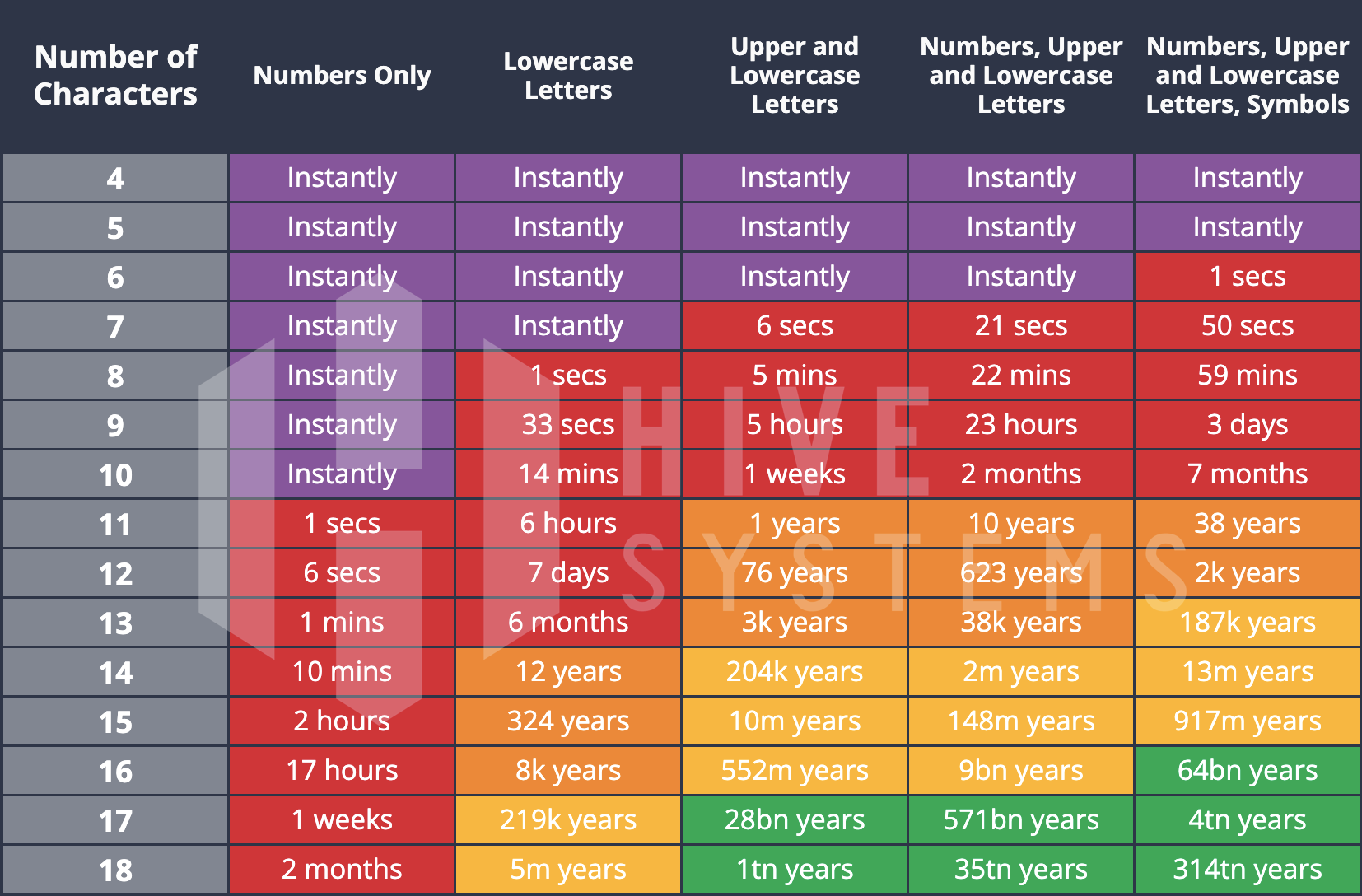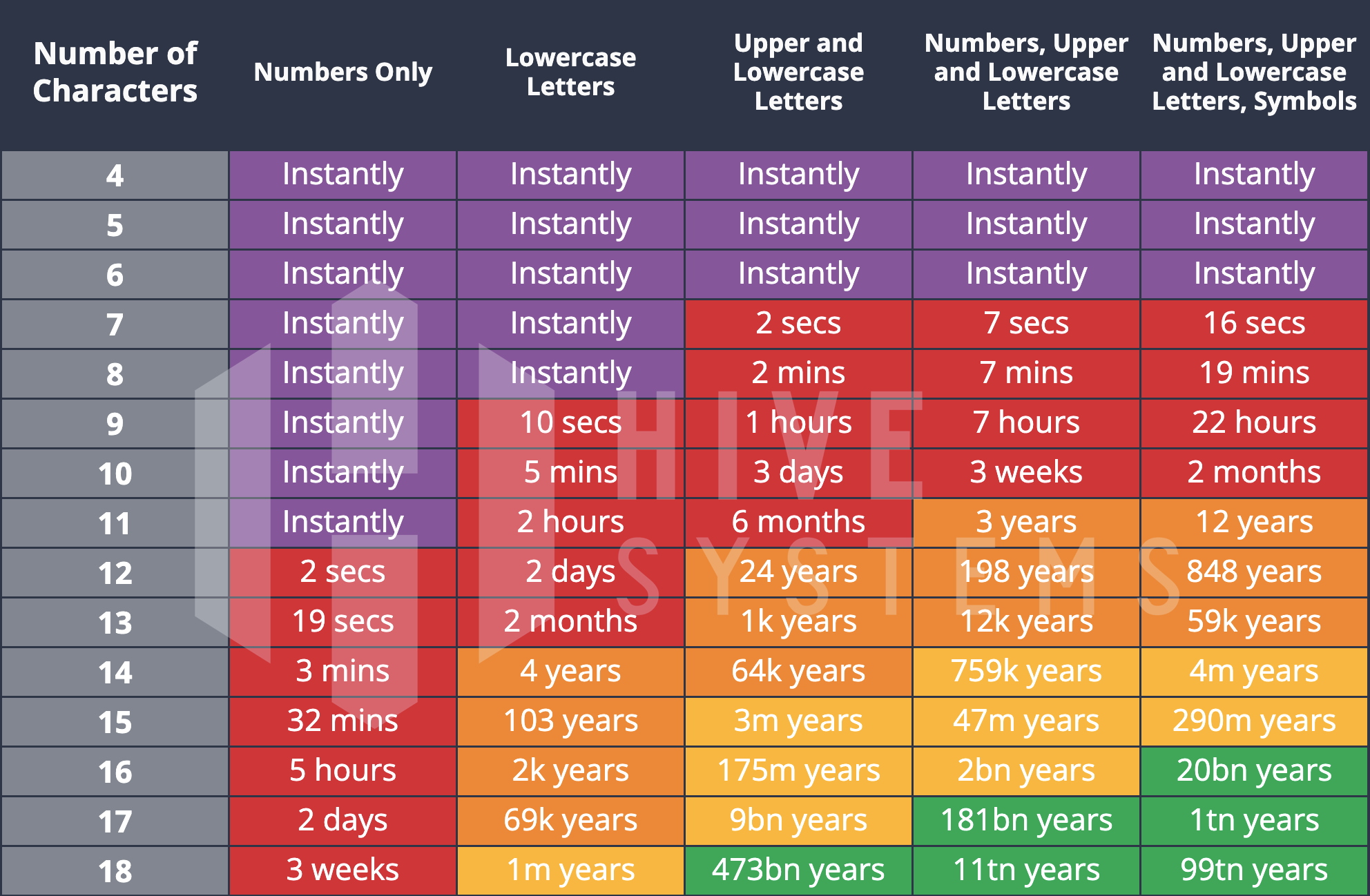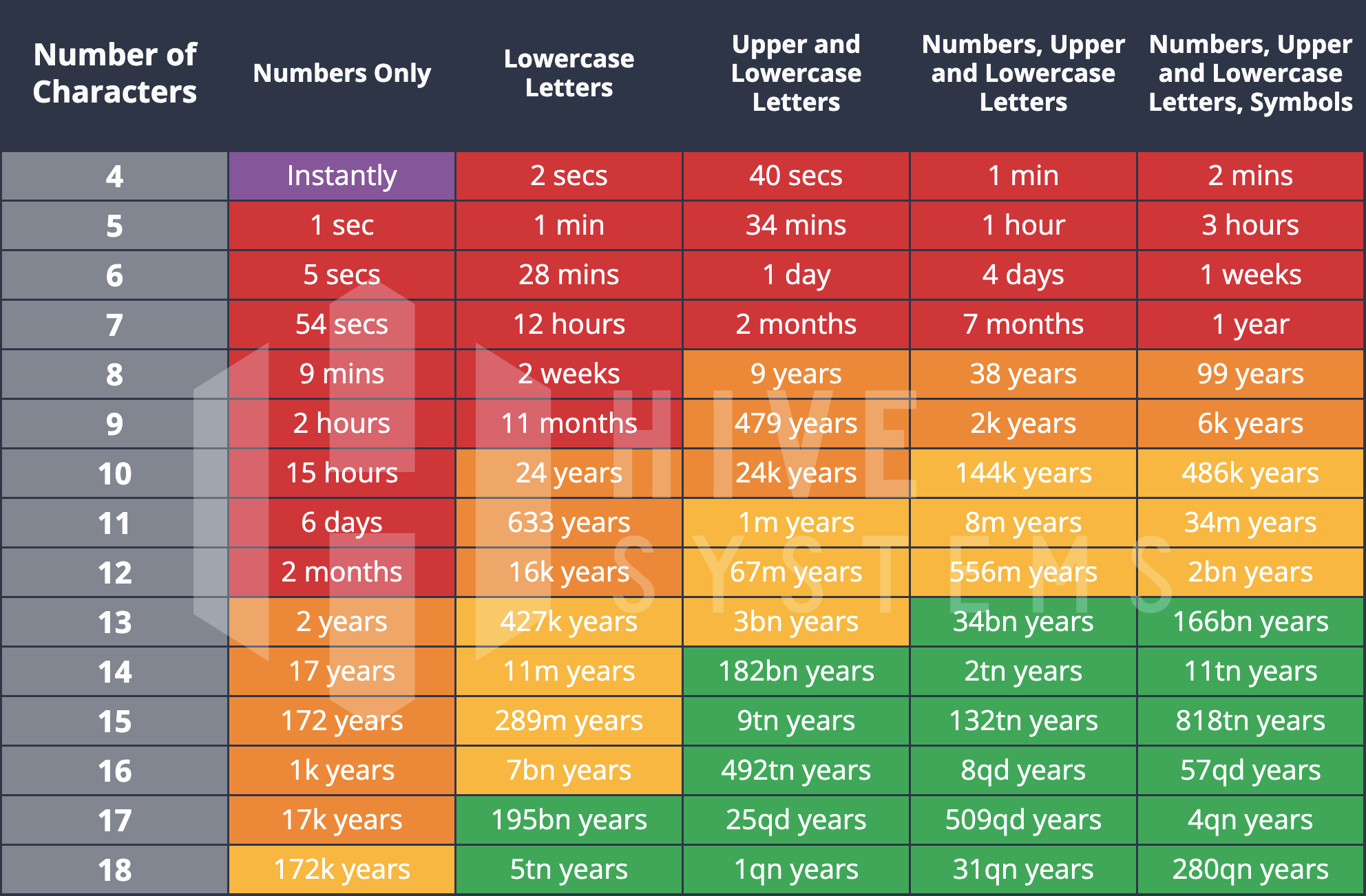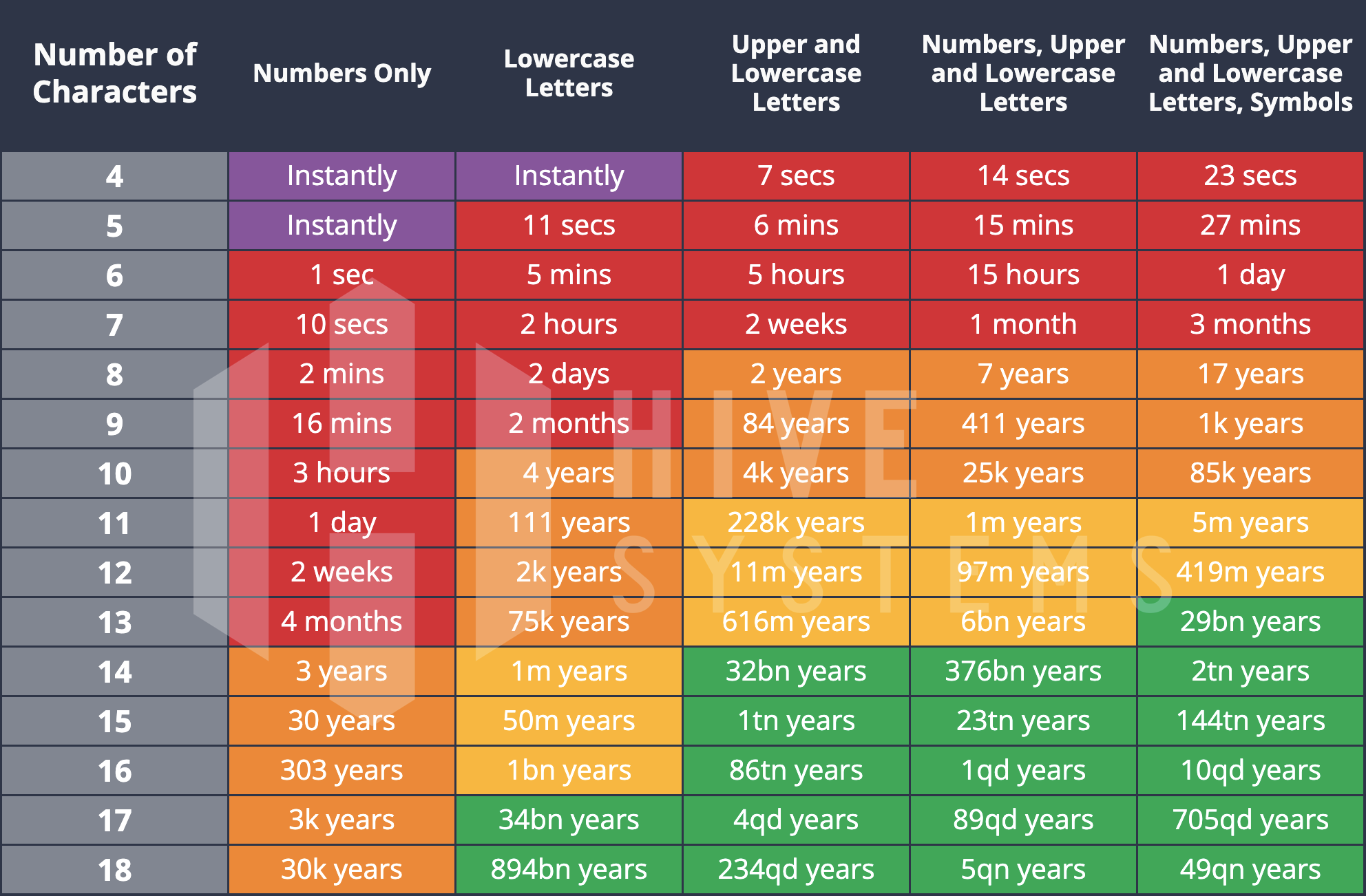Are Your Passwords in the Green?
It’s here! The 2023 update to the Hive Systems Password Table that’s been shared across the internet, the news, universities, and by thousands of organizations worldwide. So what’s new, and how did we generate this eye catching table? Keep reading below!
Not a reader? Check out our video review of this year’s table instead!
Looking for high resolution versions to download? Or the table in other languages?
Looking at Passwords in 2023
Since 2020, we’ve conducted a lot of research to develop and present the Hive Systems Password Table. But for those of you that want to know about the “how” then you’ve come to the right place because we’re going to walk you through our methodology. While the data fits nicely into the table above, things aren’t as as simple as they look. So we’ll talk through the data, our assumptions, and oh, you’re going to see a LOT of variations of the password table.
Got a question or comment? Leave it below or message us on your favorite social media platform.
Heard about the LastPass breach? Check out the variations of our Password Table for that exact scenario and see how you may be impacted.
“So how'd you make the table"?”
In 2022, we shared our update to a colorful infographic table that showed the relative strength of a hashed password against a cracking attempt, based on the password’s length, complexity, hashing algorithm used by the victim, and the hardware used by the attacker. The data was based on how long it would take a consumer-budget hacker to crack your password hash using a desktop computer with a top-tier graphics card and then how long an organized-crime-budget hacker would take leveraging cloud compute resources. We looked at big name providers like Amazon AWS and Microsoft Azure but also the growing non-corporate options where you can rent a person’s computer at cost per hour.
This year we’ve updated our cracking hardware to the latest and greatest, including that of the internet darling ChatGPT! We also opted for a more realistic set of special characters in our testing. Most websites only accept these ^*%$!&@# and so we dropped the rest. This only impacts the right-most column of the password table.
First, let’s get some key terms out of the way. We’re going to talk about “hashing.” In the context of passwords, a “hash” is a scrambled version of text that is reproducible if you know what hash software was used. In other words, if your friend hashes the word “password” using MD5 hashing software, the output hash will be 5f4dcc3b5aa765d61d8327deb882cf99. Now if you hash the word “password” using MD5 hashing software, you’ll also get 5f4dcc3b5aa765d61d8327deb882cf99! You and your friend both secretly know the word “password” is the secret code, but anyone else watching you just sees 5f4dcc3b5aa765d61d8327deb882cf99. Passwords are stored in servers as hashes like this instead of in plain text like “password.” That way, if someone steals the database all they can see are these hashes but not the password that made them.
You can’t do the reverse. A hash digest like 5f4dcc3b5aa765d61d8327deb882cf99 can’t be computed to produce the word “password” that was used to make it. Hashing software is a one-way-street by design. The way that hackers solve this problem is by “cracking” the passwords instead. In this context, “cracking” means making a list of all combinations of characters on your keyboard and then hashing them. Then you look for matches between the list and a breached database of password hashes. You can do that with any computer, but it is much faster if you accelerate the process with a powerful graphics card.
Graphics cards are those circuit boards that stick out of your computer’s bigger green circuit board. Among other things, this special circuit board has a GPU on it. A GPU is the shiny square tile on your graphics card that says NVIDIA or AMD on it. GPU stands for graphical processing unit – they were built to make pictures load faster on your computer screen (and to play great video games). As it turns out, they’re also great at calculating hashes too. A popular application for hashing is called Hashcat. Hashcat includes hashing software like MD5 and allows you to try not just MD5 but thousands of others and see how fast it was able to do so. We usually say “hash function” instead of “hash software.”
Our first password table in 2020 used data from 2018 based on MD5 hashed passwords cracked by an RTX 2080 GPU.
We based our first password table (above) and time estimates on 2018 GPU (RTX 2080 graphics card) and 2018 security practices (MD5 hashing). In fact, that appears to still be the assumption many “How strong is my password?” sites are going by. The 2022 top GPU, whether you were gaming or amateur crypto-mining, was the RTX 4090. The table below compares the two cards in terms of calculations per second and hashes per second.
When shopping for a graphics card or cloud GPU, you’re given “calculations per second,” usually in “floating point operations per second” (FLOPS). The FLOPS measure doesn’t take into account the unique properties of hashing algorithms, password character composition, and the hardware “around” the graphics card like your motherboard, CPU, and RAM. Fortunately, hashcat made it easy for password recovery experts to automate testing their hardware on real hashing exercises and then log the results to share. The result is an ever-growing dataset of observed hashing performance using various hardware and hashing approaches called “benchmarks”.
In 2018 the RTX 2080 card cracked about 37 billion hashes per second (H/s). Sites hosting Mark Wales’ HowSecureIsMyPassword (HSIMP) code rounded that up to 40 billion H/s. Many sites continue to assume that hardware and crack speed for some reason.
In 2020 we found that the RTX 3090 cracked about 70 billion H/s.
In 2022 we saw the RTX 4090 crack about 164 billion H/s.
“So how much faster is that in terms of time?”
Assuming the 8-character password recommendation from NIST is used:
Max time required to crack 8-character MD5 password hashes of various complexity.
So, random, complex 8-character passwords that once took four hours to crack now only take one. If you leverage consumer cloud computing, minutes, if you leverage enterprise cloud computing instant.
Let’s look at the tables side by side.
Password tables comparing MD5 hashes cracked by the 2080, 3090, and 4090.
“This seems like a job for the cloud, right?”
And right you are. Anyone can play with the cloud(s) now, hurray! But “everyone” includes hackers:
Password tables comparing MD5 hashes cracked by one RTX 4090 against 8 A100 GPUs from Amazon AWS.
And for comparison, here’s how things keep stacking up:
Max time required to crack 8-character MD5 password hashes of various complexity.
If you have the cash, you can rent the ungodly power of Amazon’s high performance computing clusters. At the moment, Amazon offers renting 8 NVIDIA A100 Tensor Core GPUs through their EC2 P4d offering called “p4d.24xlarge” and advertised as the “highest performance for ML training and HPC applications in the cloud,” at just $32.77 per hour. Not fast enough? Buy more instances! Note that these are the maximum amounts of time it would take to crack a password, so you’d most likely be spending less. The more instances you have running in parallel, the less time it will take.
Going back to our consumer-grade hacker point of reference, let’s assume we want to spend less money and avoid the big corporate cloud. Sites like vast.ai enable regular people to rent out their computer hardware through their residential internet connection. At the time of writing, the top performing rental was not one, but twelve RTX 4090s for the low, low price of $6 per hour! We don’t know anything about the security or business practices of vast.ai, so tread carefully.
| MD5 | Calculations per second (FP32 aka float) FLOPS | Hashes per second (H/s) |
|---|---|---|
| RTX 2080 | 10,070,000,000,000 | 37,085,000,000 |
| RTX 3090 | 35,580,000,000,000 | 69,379,700,000 |
| RTX 4090 | 82,580,000,000,000 | 164,100,000,000 |
| 8 x A100s | 155,920,000,000,000 | 517,742,464,000 |
| 8 x RTX 4090s | 660,000,000,000,000 | 1,312,800,000,000 |
| 12 x RTX 4090s | 1,237,200,000,000,000 | 1,939,500,000,000 |
Comparison of an RTX 2080, RTX 3090, RTX 4090, and the A100x8, RTX 4090x8 and RTX 4090x12 GPUs calculations per second and hashes per second.
“But what about my favorite chatbot ChatGPT?”
In the spirit of creative grand conspiracy theories sophisticated counterfactual reasoning:
Suppose you trick venture capitalists into funding your AI project but then use that power for evil to crack passwords. ChatGPT was trained on a Microsoft Azure supercomputing offering consisting of 10,000 NVIDIA A100 GPUs.
What would the password table look like under the influence of that kind of hardware?
We couldn’t get our hands on 10,000 A100s to run a test but we can infer based on how FLOPS scale linearly with Hashes. FLOPS are the advertised “calculations per second'' in general that GPU manufacturers write on the box. Hashes per second are the results of actual hashing exercises using hashcat. In other words, they differ but they differ consistently.
Comparison of several GPUs calculations per second and MD5 hashes per second with a trend line for H/s.
If we zoom into just the A100s we can see there is still a trend:
Comparison of A100 x1,4,8,12, and 10,000 GPUs calculations per second and MD5 hashes per second with a trend line for H/s.
If we multiply the speed for one A100 to 10,000 and add the same degradation factor we saw for the others of (about 5.5%) that allows us to fill in the last row of our table as:
| MD5 | Calculations per second (FP32 aka float) FLOPS | Hashes per second (H/s) |
|---|---|---|
| 8 x A100s | 155,920,000,000,000 | 517,742,464,000 |
| 12 x A100s | 233,880,000,000,000 | 776,613,696,000 |
| 10,000 x A100s | 194,900,000,000,000,000 | 647,178,080,000,000 |
Comparison of an A100 x8 x12 and x10,000 GPUs calculations per second and hashes per second.
For comparison, take a look at how all of these are stacking up NOW:
Max time required to crack 8-character MD5 password hashes of various complexity.
And if you’ve been wondering about how bad ChatGPT will be on the password cracking industry, look no further than this grim table:
Time it takes the same hardware for ChatGPT to crack passwords.
“Wait… who still uses MD5 to hash their passwords in 2023?”
Good point! GPUs can generate MD5 hashes very quickly, while other hashing functions make the process slow by design. Though there are a surprising number of sites still using MD5, let's give people the benefit of the doubt and assume they hash all their passwords with bcrypt instead. bcrypt also has salting built-in and ends up being stronger than salting MD5 (and many other hash implementations).
Password tables comparing bcrypt hashes cracked by the RTX 3090 against 8 A100 GPUs from Amazon AWS (Amazon EC2 p4d.24xlarge with 8 NVIDIA A100 SXM4 40 GB cards).
In bcrypt terms, the consumer GPU hardware can only handle 184,000 hashes per second, while the EC2 instance with the 8 A100 GPUs handles 1,081,800.
“So how did you pick just one of these to be ‘the 2023 Password Table’?”
We reviewed password data breaches from 2007 to present, reported through HaveIBeenPwned, to see what attackers have actually been trying to crack and whether that changed over time. Generally speaking, website logins that people probably care less about, like forums and restaurants, used and continue to use MD5 and SHA-1. That is a pretty big deal assuming people reuse the same passwords on more sensitive sites like banking, government, private messaging, email, and social media.
Password storage solutions like LastPass, 1Password, and Bitwarden use a hashing approach called PBKDF2 with a strong hash alternative to MD5 called SHA-256. Even NIST recommends PBKDF2 SHA-256. But we also found that things look different “in the wild.” Breached password hashes from Dropbox, Ethereum, MyFitnessPal and DataCamp all appear to use the password-hashing function bcrypt instead of a key derivation function like PBKDF2. Bcrypt also seems to be the more secure option in terms of resources required to crack it.
Until we see more PBKDF2 or bcrypt implementations we figure it is best to stick with MD5 for this year’s password table. If the site you are wondering about discloses which hashing implementation they use then see the respective table for that hash.
As a result, the 2023 Hive Systems Password Table is based on the power of the RTX 4090 with 12 GPUs against MD5. We hope in future years we stop seeing the use of MD5 and push the purple back to the top!
“What about the elephant in the room: what if my password has been previously stolen, uses simple words, or I reuse it between sites?”
Our password table focuses on the idea that the hacker is working in a “black box” situation and is having to start from scratch to hack your hash. Through the use of rainbow tables, dictionary attacks, and previously stolen hashes, your password table may (unsurprisingly) look like this:
Password table if your password has been previously stolen, uses simple words, or if you reuse it between websites.
Limitations of Our Work
Cracking passwords this way assumes that the attacker has acquired a hash digest of one or more passwords, such as those found in password data breaches on HaveIBeenPwned or more recently LastPass!
The implied attack assumes that MFA is not used or has been bypassed. If you can get access to download the encrypted database, like what happened with LastPass, you don’t need to deal with MFA when making attempts thereafter.
These metrics assume that passwords are randomly generated. Non-randomly generated passwords are much easier and faster to crack because humans are fairly predictable. As such, the time frames in these tables serve as a “best case” reference point. Passwords that have not been randomly generated would be cracked significantly faster.
These metrics assume you’re using a password that has not been part of a breach in the past. Attackers will try hashes to all common and breached passwords before bothering to crack new ones.
Think of how vast the LastPass breach was. 30 million customers’ secrets were stolen. But as of publishing this article, you won’t find the LastPass breach represented in HaveIBeenPwned. Why? Because the trove of passwords hasn’t surfaced in public yet! Imagine how many stolen secrets and vulnerabilities never reach the light of day or even the dark web. I’d speculate keeping secrets secret gives more leverage and power to criminals than releasing them.
Hashcat defaults to 999 iterations for PBKDF2 SHA-256 but that doesn’t represent what people use. NIST recommends a minimum of 10,000 iterations and sites like LastPass (now) use 600,000, and 1password 650,000 iterations.
Hashing a bunch of character combos is only one step to “cracking.” The second step is looking for matches between the hashed strings and the breached hashed password dataset. We assume that this lookup requires a trivial amount of additional computation and time.
Last time we included all QWERTY keyboard symbols but this year we stuck with the set commonly accepted on most websites and generated by most password generators ^*%$!&@# . That choice only impacts the last column of our tables.
| Encoding | Alias | Character Range | Characters |
|---|---|---|---|
| ASCII | Lowercase | a-z | 26 |
| ASCII | Uppercase | A-Z | 26 |
| ASCII | Numbers | 0-9 | 10 |
| ASCII | Symbols A | ^*%$!&@# | 8 |
Acknowledgements
Thank you everyone who commented on last year’s Password Table here on the site, on Reddit, Twitter, YouTube, via email and everywhere else!
Thank you @Chick3nman512 for answering our questions and sanity checking our hashcat results!
Thank you Roger K for checking our math and helping us realize we forgot to put in the right table for this year!
References
Hashes per second (H/s) benchmarks were either generated by Hive Systems using hashcat, or were collected from Github repo/gist search results containing other people’s hashcat outputs (e.g. https://github.com/search?q=hashcat+benchmark).
We obtained GPU hardware specs from the manufacturer or www.techpowerup.com/gpu-specs.
Want to see tables from past years?
Follow us - stay ahead.











